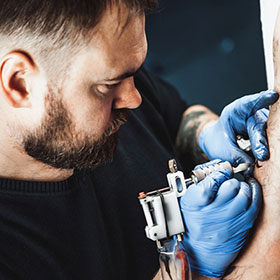Tattoos are a popular form of self-expression. They come in many styles and designs.
Tattoos have been around for centuries. Each type of tattoo has its own unique meaning and history. Some people choose tattoos to honor loved ones, while others pick designs that reflect their personal style or beliefs. Whether you are getting your first tattoo or adding to your collection, understanding the different types can help you make a more informed choice.
From traditional to modern designs, the world of tattoos offers endless possibilities. In this blog post, we will explore various types of tattoos, giving you a better idea of what might suit your taste and personality. Let’s dive into the fascinating world of tattoo art.
Traditional Tattoos
Traditional tattoos, often referred to as “old school” tattoos, are one of the most recognizable and enduring styles in the world of body art. Known for their bold lines, vibrant colors, and iconic imagery, traditional tattoos have a rich history and continue to be a popular choice for tattoo enthusiasts.
Origins
The origins of traditional tattoos can be traced back to the early 20th century. Sailors were among the first to embrace this style, using tattoos as a way to mark their travels and experiences. The influence of sailor culture is evident in the common motifs found in traditional tattoos, such as anchors, ships, and swallows.
One of the key figures in the development of traditional tattoos was Norman “Sailor Jerry” Collins. He revolutionized the art form with his bold designs and innovative techniques. His work continues to inspire tattoo artists around the globe.
Key Features
Traditional tattoos are characterized by several key features:
- Bold Lines: Thick, black outlines that define the design.
- Vibrant Colors: Bright and solid colors like red, yellow, green, and blue.
- Simplified Designs: Minimal shading and straightforward imagery.
- Iconic Motifs: Common symbols include roses, daggers, hearts, and pin-up girls.
These features make traditional tattoos easily recognizable and timeless. Their simplicity and boldness ensure they remain striking and clear even as they age.
Traditional tattoos often carry deep personal meanings. They can represent love, strength, and life’s journey. The classic style and enduring appeal of traditional tattoos make them a beloved choice for tattoo collectors and newcomers alike.
Realism Tattoos
Realism tattoos are a popular choice for those who love detailed art. These tattoos look like photographs on the skin. They capture every tiny detail. Realism tattoos require skilled artists. They use shading and fine lines to create lifelike images.
Photorealistic Designs
Photorealistic designs are a subset of realism tattoos. They aim to replicate real-life images as closely as possible. This style focuses on details like shadows, highlights, and textures.
- High Detail: Artists spend hours perfecting each detail.
- Shading: Shading is crucial for creating depth and dimension.
- Color: Both black and grey, as well as full color, are used.
Photorealistic tattoos often look like they have been printed on the skin. They can be portraits of loved ones, animals, or even objects. The key is the incredible attention to detail.
Popular Subjects
Realism tattoos can cover a wide range of subjects. Here are some of the most popular:
- Portraits: Faces of loved ones, celebrities, and historical figures.
- Animals: Pets, wildlife, and mythical creatures.
- Nature: Flowers, trees, and landscapes.
- Objects: Musical instruments, vehicles, and everyday items.
Portraits are a common choice for realism tattoos. These tattoos capture the essence and emotion of the person. Animal tattoos are also popular. They can show the beauty and majesty of wildlife. Nature tattoos bring the serenity of the outdoors to your skin. Objects can hold personal meaning, making them perfect for a realistic tattoo.
Watercolor Tattoos
Watercolor tattoos are a modern and unique style. They mimic the look of watercolor paintings. This style uses vibrant colors and soft gradients. The tattoos often appear as if they were painted on the skin with a brush. Artists blend colors seamlessly, creating a dreamy and artistic effect. Below, we explore the design techniques and color blending in watercolor tattoos.
Design Techniques
Watercolor tattoos use specific design techniques to achieve their look. Unlike traditional tattoos, they avoid harsh outlines. Instead, they focus on soft edges and fluid shapes. This creates a more natural and organic appearance.
- Brushstroke Effects: Artists replicate the look of brushstrokes.
- Splatter: This technique adds a playful touch with splattered colors.
- Gradients: Smooth transitions between colors create depth.
These techniques require a skilled hand. The artist must have a good understanding of color theory and blending.
Color Blending
Color blending is crucial in watercolor tattoos. It creates the signature look of this style. Artists use various methods to blend colors seamlessly.
- Wet-on-Wet: Applying colors while the ink is still wet for smooth transitions.
- Layering: Building up colors in layers to achieve depth and richness.
- Feathering: Softening the edges of colors to avoid harsh lines.
Effective color blending results in a cohesive and vibrant tattoo. It mimics the fluidity and lightness of a watercolor painting.
Watercolor tattoos are a beautiful and artistic choice. They stand out with their unique design techniques and expert color blending. If you want a tattoo that looks like a piece of art, consider a watercolor tattoo.
Tribal Tattoos
Tribal tattoos have a rich history and deep meaning. They are one of the oldest tattoo styles. These designs often use bold black lines and simple shapes. Tribal tattoos can be both beautiful and symbolic.
Cultural Significance
Tribal tattoos hold great cultural importance. Different tribes use tattoos to show their identity. These designs can tell stories of the wearer’s heritage. They can also signify rites of passage or achievements.
In some cultures, tattoos mark stages of life. For example, a tattoo can show a person’s journey from childhood to adulthood. Each mark has a special meaning and tells part of their story.
Common Patterns
Tribal tattoos often feature specific patterns. These patterns include spirals, lines, and geometric shapes. Each design has its unique look and meaning. Some designs are symmetrical and others are more free-flowing.
Many tribal tattoos use animal imagery. These images can represent strength, courage, or wisdom. For example, a lion might symbolize bravery. Other common elements include sun, moon, and stars. Each element adds to the tattoo’s story.
New School Tattoos
New School Tattoos are vibrant and bold. They emerged in the late 1980s. Artists use bright colors and exaggerated designs. These tattoos often feature cartoonish characters. They can include animals, people, or objects. New School Tattoos have a fun and playful look.
Stylistic Elements
New School Tattoos have thick outlines. These give the designs a comic book feel. They use bright and bold colors. This makes the tattoos stand out. The designs are often exaggerated. This adds a whimsical touch. Artists use shading to create depth. This makes the tattoos look three-dimensional. New School Tattoos are eye-catching. They demand attention.
Influences
New School Tattoos draw from various sources. Comic books and graffiti art are major influences. Cartoons also play a big role. These sources inspire the playful designs. Pop culture is another influence. You might see characters from TV shows and movies. These tattoos also reflect the artist’s imagination. Each design is unique and creative.
Japanese Tattoos
Japanese tattoos are unique and carry deep meanings. They are an ancient art form with rich history and symbolism. This blog section explores the fascinating world of Japanese tattoos.
Historical Context
Japanese tattoos, known as Irezumi, have a long history. They date back to 10,000 BC. Originally, they were used for spiritual and decorative purposes. Later, they became a symbol of status and bravery. During the Edo period, tattoos marked criminals. This stigma still exists today. Yet, many people appreciate their artistic value.
Symbolism
Japanese tattoos are full of symbols. Each design tells a story or represents a value. Here are some common symbols:
- Dragons: They symbolize strength, wisdom, and protection.
- Tigers: They represent courage and power.
- Koi Fish: They stand for perseverance and success.
- Samurais: They embody honor and loyalty.
These symbols are often combined with other elements. For example, flowers or waves. This creates a complex and beautiful design.
| Symbol | Meaning |
|---|---|
| Dragons | Strength, wisdom, protection |
| Tigers | Courage, power |
| Koi Fish | Perseverance, success |
| Samurais | Honor, loyalty |
The beauty of Japanese tattoos lies in their depth. They are not just skin art. They are a reflection of culture and tradition.
Minimalist Tattoos
Minimalist tattoos are gaining popularity for their simplicity and elegance. These tattoos use clean lines and minimal color. They are perfect for those who want subtle yet meaningful designs.
Design Principles
Minimalist tattoos focus on simplicity and clarity. The designs are often small and use only black ink. They avoid complex patterns and shading. This makes them quick to apply and easy to maintain. Less is more in minimalist tattoos.
Popular Themes
Common themes include nature elements like stars, moons, and trees. Simple geometric shapes are also popular. Hearts, arrows, and initials are frequent choices. These themes convey deep meaning without being loud. They fit well on wrists, ankles, and behind ears.
Neo-traditional Tattoos
Neo-Traditional tattoos have surged in popularity in recent years. They blend classic tattoo styles with modern artistry. This style offers a fresh twist on the traditional tattoo aesthetic. Bold lines, vibrant colors, and intricate details define these tattoos. They capture the essence of the old while embracing the new.
Evolution From Traditional
Neo-Traditional tattoos evolved from American Traditional tattoos. The classic style features simple designs with minimal shading. Artists saw an opportunity to enhance these features. They began adding more detail and depth. This led to the birth of Neo-Traditional tattoos. The new style kept the bold lines but added richer colors. It also introduced more complex shading and textures.
Distinct Features
Neo-Traditional tattoos are known for their distinct features. They use a wider color palette. This allows for more vibrant and varied designs. The tattoos often feature intricate details. These details make each piece unique and personal. The designs are often inspired by nature, animals, and folklore. Another key feature is the use of bold, clean lines. These lines create a sharp contrast that makes the designs stand out.
Frequently Asked Questions
What Are The Different Styles Of Tattoos?
There are many styles. Popular ones include traditional, realism, watercolor, tribal, and Japanese.
How Long Does A Tattoo Take To Heal?
A tattoo usually takes 2-3 weeks to heal. Follow aftercare instructions.
Do Tattoos Fade Over Time?
Yes, tattoos can fade. Sun exposure and skin aging are common reasons.
Are Tattoos Painful?
Yes, tattoos can be painful. Pain level varies by location and individual tolerance.
What Is The Best Age To Get A Tattoo?
The best age is 18 or older. Skin is more mature and legal consent is given.
Conclusion
Choosing the right tattoo type is important. Tattoos express your personality and style. Explore different designs and meanings. Consider placement and size carefully. Research artists and their work. Ensure the tattoo suits you for life. Take your time to decide.
This makes the experience positive. Remember, tattoos are permanent. Enjoy your new tattoo with confidence.

